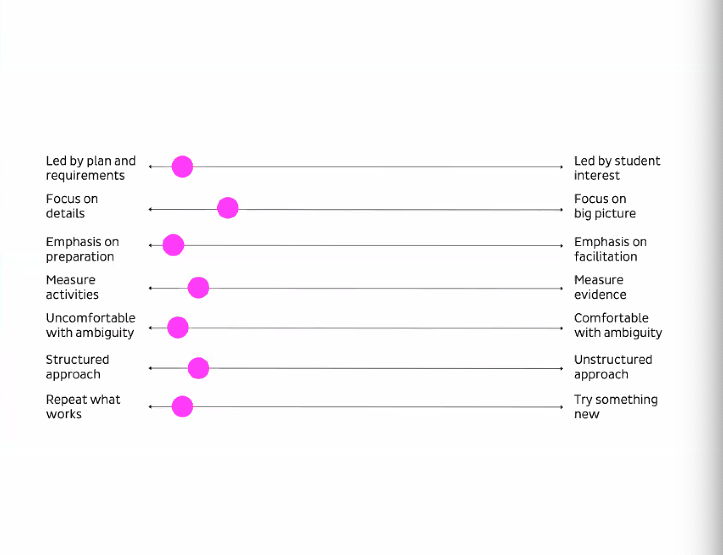
Michael's going to talk about Journal Studies, how they're under used and hopefully inspire you to use them more!
Michael worked with a peak body to investigate education in science and students performance.
He wanted to know why and how teachers used the resources available for teachers to teach science.
Many had low confidence in teaching science.
Not a lot of professional development time.
In general just not enough time to vet everything.
Many had low confidence in teaching science.
Not a lot of professional development time.
In general just not enough time to vet everything.
Planning was the part of their job they knew set them up for success, year, term, week planning — aligning to the curriculum outcomes, identifying the resources and content and gave them the structure for evaluating the students.
This planning mindset was built into the resources that had already been created
Michael focused on the gaps and employed a journal study — they found that it wasn't actual the linear structure of planning they were being told it is.
Little people aren't homogenous, and teachers respond to this flexibly.
Little people aren't homogenous, and teachers respond to this flexibly.
A teacher is having to constantly navigate and adapt to create a learning experience
Where there heart lies is being in the room with the students.
The planning, while important, wasn't where the practice is.
The planning, while important, wasn't where the practice is.
Seeing this helped Michael flip the concept of the design — putting explaining practices upfront meant teachers would skip because they were in the teaching when they were using the resource, they wanted something to help them make decision in the moment
A lot of the common design of research asks people what they feel at a certain point in time, removed from the context of the moment.
This is where Journal Studies can have a huge impact on our understanding
This is where Journal Studies can have a huge impact on our understanding
Journal Studies (Diary Studies)
You set up the questions and participants answer them closer to context over a period of time.
You set up the questions and participants answer them closer to context over a period of time.
The barriers to doing this sort of research has dropped significantly, we carry a phone with a camera and we're fairly used to filming ourselves.
Once you have it set up for one group of people it's fairly easy to scale
Journal Studies give you insights about context and time, two things very difficult for us as researchers to uncover in person.
Participants record their thoughts in the moment, you get to see real stuff going on because you've removed the barriers of someone watching. You'll get videos in the car, doing the dishes, musing in bed at night.
You build up a personal empathy with people and get to know them.
You get to see the full picture — specifically the environment.
It helps you understand why behaviours are happening and the environment that creates those behaviours.
It helps you understand why behaviours are happening and the environment that creates those behaviours.
There are so many things that happen in the home, important decision on the couch.
You can make accurate and focussed decisions about the behaviours.
You can make accurate and focussed decisions about the behaviours.
Michael got to see the prioritisation that came with time constraints for teachers.
Saw noisy classrooms, science equipment failing, overbearing principles, clutterred desks.
All of this helped the team make better decisions about how to design their resources.
All of this helped the team make better decisions about how to design their resources.
Think about what you want participants capturing the moment:
What: thoughts/impressions, photos, sounds
When: before, during, after
What: thoughts/impressions, photos, sounds
When: before, during, after
Be creative with it, it's fun and interesting to look at the methods.
It has to be interesting for the participants as well.
Don't make it too hard for them to do.
It has to be interesting for the participants as well.
Don't make it too hard for them to do.
Watch behaviours change and evolve.
It helps you suss out the overarching picture and what's really happening.
Asking someone on payday Vs when they're paying a bill about finances you'll get a different answer, so seeing the spectrum is illuminating
It helps you suss out the overarching picture and what's really happening.
Asking someone on payday Vs when they're paying a bill about finances you'll get a different answer, so seeing the spectrum is illuminating
Mistakes Michael learned from
1: Too long, they set the study for a full term (10 weeks) they struggles to keep teachers engaged.
How long before you actual see a pattern emerge
2. Not reacting, we didn't modify the study based on what we'd already seen.
1: Too long, they set the study for a full term (10 weeks) they struggles to keep teachers engaged.
How long before you actual see a pattern emerge
2. Not reacting, we didn't modify the study based on what we'd already seen.
You might use a journal study when you want to see a breadth of experiences in depths you can't get to in a single moment of time.
When you want the nuance that quickly fades from our memory.
Surfacing the micro-moments that lead to a decision.
When you want the nuance that quickly fades from our memory.
Surfacing the micro-moments that lead to a decision.
To know about sporadic behaviours
Reach hard to access groups
Reach hard to access groups
What you get at the end of your journal study is rich multi media outputs.
The empathy you build from watching real people is deep and nuanced.
The empathy you build from watching real people is deep and nuanced.
@threadreaderapp unroll please
• • •
Missing some Tweet in this thread? You can try to
force a refresh






